World War II
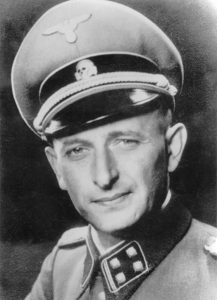 As World War II was winding down, and it was becoming abundantly clear that Nazi Germany was not going to win, the “brave” leaders of the Third Reich began to make plans to run out on their Army, leaving them to take the fall alone. The Nazi leaders were given aliases, and plans were made to get them to Argentina, a country known for its lax immigration policies. The Nazis planned to regroup in Argentina and try for world domination again at a later date.
As World War II was winding down, and it was becoming abundantly clear that Nazi Germany was not going to win, the “brave” leaders of the Third Reich began to make plans to run out on their Army, leaving them to take the fall alone. The Nazi leaders were given aliases, and plans were made to get them to Argentina, a country known for its lax immigration policies. The Nazis planned to regroup in Argentina and try for world domination again at a later date.
Hitler’s hatred for Jews, like any racism was not logical. The Jewish people had done nothing to Hitler or any other German person. This was just a sick personal idea of Hitler’s. It comes from an intolerance to the differences that are naturally occurring in humans, and why would we want to all look the same anyway. It makes no sense at all. Different people have different things to contribute to any society, but Hitler could only see his own twisted idea of a perfect person…odd, when you consider the fact that Hitler would not have fit into his own mold of “perfect” at all. Hitler had a number of conditions that would have, by his own standards, have precipitated his death by the very people who enforced Hitler’s laws.
The man Hitler put in charge of his “final solution of the Jewish question,” Adolf Eichmann, was a man who’s racism and evil personality were quite likely equal to Hitler’s. I have no idea how anyone could plan the murder 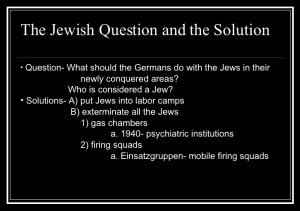 of millions of people, of any race, without that person being evil itself. Eichmann was just that. He knew what he was doing, and he relished the idea of “being a god” over those people’s lives…choosing who lives and who dies. Most of us dislike jury duty, because we don’t want to make such decisions for fellow citizens, but Eichmann loved it…thrived on it.
of millions of people, of any race, without that person being evil itself. Eichmann was just that. He knew what he was doing, and he relished the idea of “being a god” over those people’s lives…choosing who lives and who dies. Most of us dislike jury duty, because we don’t want to make such decisions for fellow citizens, but Eichmann loved it…thrived on it.
Eichmann was born in Solingen, Germany, in 1906. Eichmann joined the Nazi’s elite SS (Schutzstaffel) organization in November 1932. The members of the SS came to have broad responsibilities in Nazi Germany, including policing, intelligence, and the enforcement of Adolf Hitler’s anti-Semitic policies. Eichmann was good at his job, and steadily rose in the SS hierarchy. When the Nazis annexed Austria in 1938, Eichmann was sent to Vienna, His mission…rid the city of Jews. He set up an efficient Jewish deportment center and in 1939 was sent to Prague on a similar mission. That year, Eichmann was appointed to the Jewish section of the SS central security office in Berlin. I don’t know how he could have looked himself in the mirror.
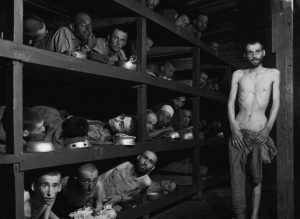 After the war, Eichmann was captured by US troops. Somehow, he managed to escape from the prison camp in 1946, before the Nuremberg International War Crimes Tribunal. Taking an assumed identity, Eichmann traveled between Europe and the Middle East. Finally, in 1950 Eichmann arrived in Argentina. In 1957, a German prosecutor secretly informed Israel that Eichmann was living in Argentina. Time had not forgiven the crimes Eichmann had committed. Agents from the Mossad, Israel’s intelligence service, were deployed to Argentina, and in early 1960 they finally located Eichmann. He was living in the San Fernando section of Buenos Aires under the name of Ricardo Klement. He was taken back to Israel, and on May 31, 1962, he was finally hanged for his horrific crimes against humanity.
After the war, Eichmann was captured by US troops. Somehow, he managed to escape from the prison camp in 1946, before the Nuremberg International War Crimes Tribunal. Taking an assumed identity, Eichmann traveled between Europe and the Middle East. Finally, in 1950 Eichmann arrived in Argentina. In 1957, a German prosecutor secretly informed Israel that Eichmann was living in Argentina. Time had not forgiven the crimes Eichmann had committed. Agents from the Mossad, Israel’s intelligence service, were deployed to Argentina, and in early 1960 they finally located Eichmann. He was living in the San Fernando section of Buenos Aires under the name of Ricardo Klement. He was taken back to Israel, and on May 31, 1962, he was finally hanged for his horrific crimes against humanity.
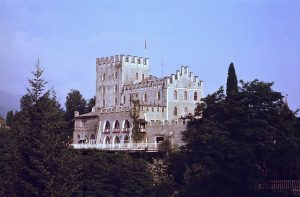 World War II was one time when the United States and Germany were absolutely not friends. The Nazi beliefs and the American beliefs were worlds apart. Nevertheless, not all Germans were Nazis, and hard to believe as that may be, it was true. Never was that more evident that at Castle Itter, a small fortification in Austria used by the SS during World War II as a prison for high profile detainees. On May 6, 1945, with the Third Reich collapsing against the Allied attacks, the German commander of Dachau, Wilhelm Weiter committed suicide. At that point, some of the Waffen SS soldiers retreated, and amid the chaos that followed, the opportunity presented itself, and a Yugoslav freedom fighter, Zvonimir Cuckovic, who was a prisoner at Dachau, escaped and went looking for some Allied troops to rescue the rest of the prisoners.
World War II was one time when the United States and Germany were absolutely not friends. The Nazi beliefs and the American beliefs were worlds apart. Nevertheless, not all Germans were Nazis, and hard to believe as that may be, it was true. Never was that more evident that at Castle Itter, a small fortification in Austria used by the SS during World War II as a prison for high profile detainees. On May 6, 1945, with the Third Reich collapsing against the Allied attacks, the German commander of Dachau, Wilhelm Weiter committed suicide. At that point, some of the Waffen SS soldiers retreated, and amid the chaos that followed, the opportunity presented itself, and a Yugoslav freedom fighter, Zvonimir Cuckovic, who was a prisoner at Dachau, escaped and went looking for some Allied troops to rescue the rest of the prisoners.
Hans Fuchs, who was a young student going to school nearby, remembers how Itter Castle was converted into a prison by the Nazis in 1943. He said, “We saw everything from our school window, a double barbed-wire fence…and floodlights so that the whole night was lit up like day.” Itter Castle, is an old castle, dating back to the Middle Ages. It was turned into a sub-unit of the Dachau concentration camp, and used for VIP prisoners, prominent politicians, and military figures that the Nazis wanted to use as bargaining chips. Famous prisoners 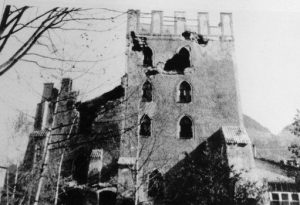 there included two former prime ministers of France, Edouard Daladier and Paul Reynaud, as well as the elder sister of Gen Charles de Gaulle, Marie-Agnes Cailliau.
there included two former prime ministers of France, Edouard Daladier and Paul Reynaud, as well as the elder sister of Gen Charles de Gaulle, Marie-Agnes Cailliau.
Cuckovic’s escape triggered one of the most curious battles of the conflict, but not in the way you might think. After he escaped, Cuckovic found an American armored column and got them to come with him. At the same time a Major Josef Gangl, who was an Austrian in the German Army, and had been collaborating with Austrian resistance in the closing days of the war, also intended to free the castle prisoners, but had decided instead to surrender with his men to the Americans. Gangl hated what was going on and knew that the Nazis were friends to no one. He could no longer stomach what he had been commanded to do. With the arrival of Cuckovic a hasty agreement took place. The major and his Wehrmacht troops would fight alongside the Americans against the SS guards.
The resulting battle of Castle Itter was not a major battle, just an amazing one. The SS faced not only their own countrymen and Americans, complete with a Sherman tank, but there were also Austrian partisans and French prisoners joining in. It was a wonderful show of the unifying effect the Allies had compared to the polarizing effect of the Nazis. The ensuing battle was not big, and in fact, a maximum of just 100 men were 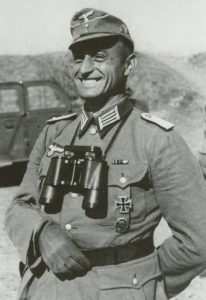 involved. Nevertheless, this battle was, without a doubt, vicious. The Sherman tank was destroyed and Major Josef Gangl was killed by a sniper. The thing that made this battle so unique, however, was that it was the only time the American army fought alongside the German army in all of World War II. The SS were handily defeated and quickly surrendered. The rest of the prisoners held at Castle Itter were released unharmed.
involved. Nevertheless, this battle was, without a doubt, vicious. The Sherman tank was destroyed and Major Josef Gangl was killed by a sniper. The thing that made this battle so unique, however, was that it was the only time the American army fought alongside the German army in all of World War II. The SS were handily defeated and quickly surrendered. The rest of the prisoners held at Castle Itter were released unharmed.
There have been times in many wars, when two soldiers made the conscious decision not to engage in battle, allowing both to live to fight another day. I suppose it would not be unheard of to have two opposing soldiers work together to defeat a common enemy, like maybe a bear or other wild animal, but for two army patrols of two opposing sides, to join forces against part of one sides army, is…well, unheard of. The battle at Castle Itter was just such a battle, and it is believed to be the only battle in the war in which Americans and Germans fought as allies.
 Shortly after the Japanese attacked Pearl Harbor, they were bent on making the most of the advantage they had, or perceived to have had. As we know the advantage was much less than they thought it was, but the United States did need a little bit of time to regroup and prepare for their entrance into World War II. The invasion of the Philippines started on December 8, 1941, just ten hours after the attack on Pearl Harbor. The US military had just lost ships and personnel, and understandably, the Japanese saw the opportunity to take advantage of the chaos. As at Pearl Harbor, American aircraft were severely damaged in the initial Japanese attack on the Philippines. A lack of air cover, forced the American Asiatic Fleet in the Philippines withdrew to Java on December 12, 1941. General Douglas MacArthur was ordered out of harms way. He was sent to Australia, 2485 miles away, unfortunately leaving his men at Corregidor on the night of March 11, 1942. Cutting off supplies, the Japanese finally forced 76,000 starving and sick American and Filipino defenders in Bataan to surrender on April 9, 1942. They were then forced to endure the infamous Bataan Death March on which 7,000 to 10,000 people died or were murdered.
Shortly after the Japanese attacked Pearl Harbor, they were bent on making the most of the advantage they had, or perceived to have had. As we know the advantage was much less than they thought it was, but the United States did need a little bit of time to regroup and prepare for their entrance into World War II. The invasion of the Philippines started on December 8, 1941, just ten hours after the attack on Pearl Harbor. The US military had just lost ships and personnel, and understandably, the Japanese saw the opportunity to take advantage of the chaos. As at Pearl Harbor, American aircraft were severely damaged in the initial Japanese attack on the Philippines. A lack of air cover, forced the American Asiatic Fleet in the Philippines withdrew to Java on December 12, 1941. General Douglas MacArthur was ordered out of harms way. He was sent to Australia, 2485 miles away, unfortunately leaving his men at Corregidor on the night of March 11, 1942. Cutting off supplies, the Japanese finally forced 76,000 starving and sick American and Filipino defenders in Bataan to surrender on April 9, 1942. They were then forced to endure the infamous Bataan Death March on which 7,000 to 10,000 people died or were murdered.
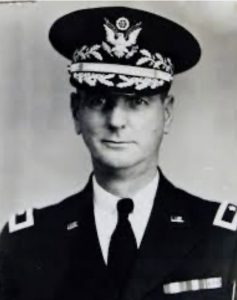
The 13,000 survivors on the island of Corregidor surrendered on May 6, 1942. It was the last holdout against the Japanese in the Philippines. The surrender of the Philippines and Corregidor was not only a sad thing…it was a death sentence for many. The island of Corregidor under the command of General Jonathan Wainwright, was hit by constant artillery shelling and aerial bombardment attacks, which ate away at the American and Filipino defenders. The troops at Corregidor managed to sink many Japanese barges as they approached the northern shores of the island with necessary supplies, but finally, cut off from supplies, the Allied troops couldn’t hold the invader off any longer. General Wainwright, who had only recently been promoted to the rank of lieutenant general and commander of the US armed forces in the Philippines, offered to surrender Corregidor to Japanese General Homma, but Homma wanted the complete, unconditional surrender of all American forces throughout the Philippines. Wainwright had little choice given the odds against him and the poor physical condition of his troops. He had already lost 800 men. He surrendered at midnight. All 11,500 surviving Allied troops were evacuated to a prison stockade in Manila.
The Japanese did not care about any kind of proper treatment of the prisoners of war. Men were beaten, 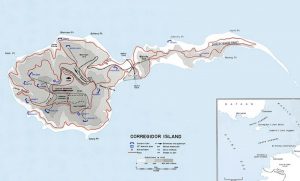 starved, and worked to death. Many of the men who surrendered at Corregidor were sent to Japan to work there. No one knew where they were, or even if they were still alive. At first, it was thought that they were in the prison camps, but people only later heard that their loved one was…who knew where. General Wainwright remained a POW until 1945. I’m sure the US government felt bad that they couldn’t help him, and so he was invited to the USS Missouri for the formal Japanese surrender ceremony on September 2, 1945. He was also be awarded the Congressional Medal of Honor by President Harry S Truman. Wainwright died in 1953…eight years to the day of the Japanese surrender ceremony.
starved, and worked to death. Many of the men who surrendered at Corregidor were sent to Japan to work there. No one knew where they were, or even if they were still alive. At first, it was thought that they were in the prison camps, but people only later heard that their loved one was…who knew where. General Wainwright remained a POW until 1945. I’m sure the US government felt bad that they couldn’t help him, and so he was invited to the USS Missouri for the formal Japanese surrender ceremony on September 2, 1945. He was also be awarded the Congressional Medal of Honor by President Harry S Truman. Wainwright died in 1953…eight years to the day of the Japanese surrender ceremony.
 Not many people these days have heard of Hedy Lamarr, but I have heard of her, because she was an actress in my parents’ era. It goes without saying that Hedy Lamarr was beautiful…by any standard. Hedy Lamarr was a star in the 1930s and 1940s, starring in some well known movies including Boom Town with Clark Gable and Samson and Delilah with Victor Mature. While she’s certainly famous because of her acting career, she didn’t make any big world changes because she starred in some old movies. Instead, Hedy Lamarr had a pastime that did change the world. You wouldn’t know it…or certainly you wouldn’t expect it…but in her spare time Hedy Lamarr liked to work on her inventions. Seriously, who would have thought that?
Not many people these days have heard of Hedy Lamarr, but I have heard of her, because she was an actress in my parents’ era. It goes without saying that Hedy Lamarr was beautiful…by any standard. Hedy Lamarr was a star in the 1930s and 1940s, starring in some well known movies including Boom Town with Clark Gable and Samson and Delilah with Victor Mature. While she’s certainly famous because of her acting career, she didn’t make any big world changes because she starred in some old movies. Instead, Hedy Lamarr had a pastime that did change the world. You wouldn’t know it…or certainly you wouldn’t expect it…but in her spare time Hedy Lamarr liked to work on her inventions. Seriously, who would have thought that?
World War II began in 1939, but after the Japanese attacked Pearl Harbor on December 7, 1941, the United States entered the war. By 1942, Lamarr was at the height of her acting career. Still, like many patriotic Americans, she wanted to help in the war effort. She could have gone in as a nurse, or something, but she had something else in mind. Hedy Lamarr wanted to help the Allies come up with a communications system that couldn’t be intercepted by enemies. Now, I can only imagine how that would have gone over in an era where woman were thought not to understand the ways of war. So she and her friend, composer George Antheil, patented an idea for something they called the “Secret Communications System.” It was a system that would change radio frequencies in a per-programmed method. I hadn’t heard of such a method, although I suppose others have. If someone was listening…and the enemy was always trying to listen, they would only hear snippets before it changed to a different frequency. It sounds logical, but ultimately, the military didn’t end up using the system.
Flash forward a few decades, and you will find that Lamarr and Antheil’s patent became really important because it was a cheap and effective way to create security in new emerging technologies like military communication, cellular phones, and WiFi. What the military couldn’t use effectively in World War II, became important part of modern-day communication, and something most of us couldn’t do without…especially in the an 
![]() middle of a global pandemic. To look at her, Hedy Lamarr would have instantly been classified as a pretty girl, but most likely with out a head for mathematics or science…especially not in the field of electronics, but that classification would have proved very wrong. Hedy Lamarr had it all…looks and brains. Her contributions to modern-day technology prove that. As for Lamarr, her film career cooled down in the 1950s and her last movie was released in 1958. She became reclusive in her later life and passed away on January 19, 2000. She was 86.
middle of a global pandemic. To look at her, Hedy Lamarr would have instantly been classified as a pretty girl, but most likely with out a head for mathematics or science…especially not in the field of electronics, but that classification would have proved very wrong. Hedy Lamarr had it all…looks and brains. Her contributions to modern-day technology prove that. As for Lamarr, her film career cooled down in the 1950s and her last movie was released in 1958. She became reclusive in her later life and passed away on January 19, 2000. She was 86.
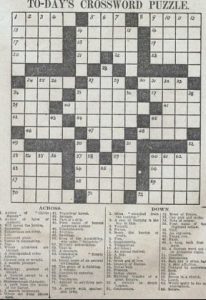 As the Allies were planning the massive D-Day assault which was intended to end World War II in Europe, some strange “coincidences” happened that almost threw a monkey wrench into the whole thing. The planned assault on Normandy, France, in 1944, was to include over 5,000 ships, 1,200 planes, and almost 160,000 men. They were set to invade Europe from the British Isles, when something almost put a stop to it…a series of crossword puzzles. Personally, I hate crossword puzzles. They are boring in my mind, so if I were to find a clue in one, it would likely be a miracle.
As the Allies were planning the massive D-Day assault which was intended to end World War II in Europe, some strange “coincidences” happened that almost threw a monkey wrench into the whole thing. The planned assault on Normandy, France, in 1944, was to include over 5,000 ships, 1,200 planes, and almost 160,000 men. They were set to invade Europe from the British Isles, when something almost put a stop to it…a series of crossword puzzles. Personally, I hate crossword puzzles. They are boring in my mind, so if I were to find a clue in one, it would likely be a miracle.
The problem began with the Dieppe Raid on August 19th, 1942. Dieppe is also in Normandy, but further North. In Dieppe, over 6,000 Allied troops, mostly from Canada, attacked at 5 AM. “They had four main goals: (1) to prove that it was possible to capture a slice of Nazi-occupied Europe, (2) to boost Allied morale, (3) to gain intelligence, and (4) to destroy coastal defenses and other sensitive installations.” The mission failed miserably, with the loss of, capture of, or retreat of almost 60% of the invading forces by 3 PM. This couldn’t have been just coincidental, and the Allies wanted to know what had happened. It seemed quite likely that the Germans had been warned of the attack. How could this have happened. Somehow, the suspicion fell on The Daily Telegraph, a British paper still in business today. I’m sure there were a number of newspapers over the years that were used to pass coded messages to the enemy. And I guess it would take a spy’s mind to figure it all out. It had to be discreet, because the paper can’t just give advance warning notice to the enemy, but they did (and still do) have a crossword puzzle section. What better avenue for coded messages. The thing that really triggered suspicion was that two days before the Dieppe invasion, the clue, “French port” was given. And the solution was “Dieppe,” given the following day…the day before the invasion. When I think about the 6,000 men that walked into an ambush because of that one puzzle, I feel furious. This wasn’t a coincidence, this was deliberate, and it was criminal.
The intelligence personnel quickly focused on Leonard Sydney Dawe…the headmaster of Strand School, who was responsible for the crossword puzzle. They were surprised to think it might be him, because he was a veteran of World War I. In addition, nothing linked him to Nazi Germany. In the end, MI5 concluded that it was just that a chilling coincidence, but was it…really? The Strand School for boys in south London, which no longer exists, still stuck out as being somehow involved. It was learned that when the Germans began their bombardment of the city in 1939, Strand was moved to Effingham in Surrey, which was close to where many American and Canadian forces were based.
The French invasion was called Operation Overlord. It was to take place on June 5th, 1944 and involve a series of joint sea and air landings along the Normandy coast. Rather than mass themselves at one spot, however, they were to land at five different areas according to nationality. The Americans were to land at two places. The first was on the left bank of the Douve estuary…codenamed Utah Beach. The second was the stretch which included Sainte-Honorine-des-Pertes, Saint-Laurent-sur-Mer, and Vierville-sur-Mer…referred to as Omaha. The 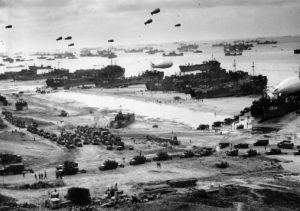 British were also given two landing sites – the first along Saint-Aubin-sur-Mer to Ouistreham…Sword Beach, as well as the strip from Arromanches-Les-Bains, Le Hamel, and La Rivière…Gold Beach. As for the Canadians, they were assigned the stretch from Courseulles, Saint-Aubin, and Bernières…Juno Beach. To ensure the quick off-loading of cargo, portable bridges called “Mulberry Harbors” were built. Ships would tow these to France, assemble them at sea, then drive equipment onto the beaches.
British were also given two landing sites – the first along Saint-Aubin-sur-Mer to Ouistreham…Sword Beach, as well as the strip from Arromanches-Les-Bains, Le Hamel, and La Rivière…Gold Beach. As for the Canadians, they were assigned the stretch from Courseulles, Saint-Aubin, and Bernières…Juno Beach. To ensure the quick off-loading of cargo, portable bridges called “Mulberry Harbors” were built. Ships would tow these to France, assemble them at sea, then drive equipment onto the beaches.
The massive size of the invasion, made it almost impossible to keep a complete secret from the Germans, so the plan was to keep them guessing as to exactly when and where the invasion would take place. It was then that the Allies launched Operation Bodyguard…a series of diversions which convinced the Germans that Normandy was simply a distraction, while the main invasion was to take place elsewhere. The Germans bought it, they didn’t want to take any chances. As a result, they stretched their forces thin in a desperate attempt to cover all of their bases. To keep them off balance, absolute secrecy was vital.
Then, in February 1944, one of The Daily Telegraph’s crossword answers was “JUNO.” The following month, it was “GOLD,” and the month after that, it was “SWORD.” Coincidence? MI5 thought so. Then, when the next puzzle included the clue, “One of the US,” they began to wonder. The next day, the answer given was “UTAH.” This was really too much, and MI5 was getting worried. As soon as the May 22nd edition came out, MI5 anxiously grabbed a copy. Scanning the crossword section, they found yet another suspicious clue…“Red Indian on the Missouri River.” And what was the answer given the next day? “OMAHA.” Lets just say, they were getting nervous. Still, it got worse. The May 27th edition had another damning clue…“Big-Wig.” And the answer was? “OVERLORD.” The clincher came on June 1…four days before lift-off. The solution to 15 Down was “NEPTUNE.”
Dawe was arrested at his school to the astonishment of the students and staff. They then banned the paper’s next publication in case “DDAY” appeared in the next crossword. The US Coast Guard manned USS LST-21 unloads British Army tanks and trucks onto a “Rhino” barge during the early hours of the invasion on Gold Beach, 6 June 1944. Dawe was released after the invasion but refused to speak about his ordeal till 1958. He admitted that they did turn him “inside-out,” and had D-Day turned into another Dieppe, he might have been shot. Many people thought it was all just a coincidence…at least till 1984 when Ronald French, a former student at Strand, came forward. As it turns out, Dawe didn’t create crossword puzzles. He instead had students arrange words on a grid, and when he was satisfied, provided clues to solve them by. Then he’d send the finished work to the paper, taking credit for the work. According to French and other former students who later came forward, everyone in Surrey knew the code words. It seems that because they all hung around the Americans and Canadians, the words had leaked out. The French didn’t know what the words meant, only that the servicemen often said them. So when told to work on the crossword puzzles, he included the codes. After his release, Dawes confronted French and accused him of putting the entire country at risk, but how had this 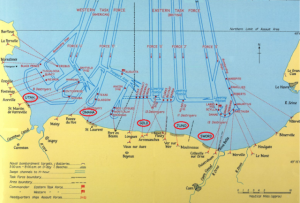 happened. It seems that despite their own secrecy, the MI5 had apparently forgotten to tell the army to keep their mouths shut. It all came about because when the Allies believed that the war was turning in their favor, the Third Washington Conference…also called the Trident Conference…was held in Washington, DC in May 1943. It was there that plans for an Allied invasion of Sicily, France, and the Pacific were discussed. The careless soldiers that spilled the code words almost cost the Allies the victory. D-Day was a battle that cost the Allies many lives, but it could have been much worse, if the secrets had been passed to the enemy in a way that they could have understood them.
happened. It seems that despite their own secrecy, the MI5 had apparently forgotten to tell the army to keep their mouths shut. It all came about because when the Allies believed that the war was turning in their favor, the Third Washington Conference…also called the Trident Conference…was held in Washington, DC in May 1943. It was there that plans for an Allied invasion of Sicily, France, and the Pacific were discussed. The careless soldiers that spilled the code words almost cost the Allies the victory. D-Day was a battle that cost the Allies many lives, but it could have been much worse, if the secrets had been passed to the enemy in a way that they could have understood them.
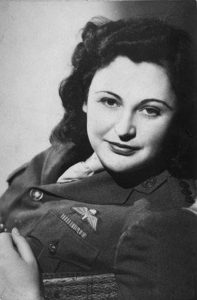 When I think of some of the civilian heroes of our wars, I find myself amazed at the many courageous acts they carried out. They threw caution to the wind and moved about among the enemy, somehow managing to remain almost invisible. They had code names and secret pasts that no one knew about, not even the people they worked with…and definitely not the enemy they worked against.
When I think of some of the civilian heroes of our wars, I find myself amazed at the many courageous acts they carried out. They threw caution to the wind and moved about among the enemy, somehow managing to remain almost invisible. They had code names and secret pasts that no one knew about, not even the people they worked with…and definitely not the enemy they worked against.
One of these spies was Nancy Grace Augusta Wake, who was also known by her married name, Nancy Fiocca. Wake was a New Zealand-born nurse and journalist, who joined the French Resistance and later the Special Operations Executive (SOE) during World War II. Born August 30, 1912 in Roseneath, Wellington, New Zealand, the youngest of the six children of Charles Augustus Wake and Ella Rosieur Wake. In 1914, the family moved to Australia and settled at North Sydney. Shortly thereafter, Wake’s father returned to New Zealand and her mother raised the children. In Sydney, Wake attended the North Sydney Household Arts (Home Science) School.
At the age of 16, she ran away from home and worked as a nurse. With £200 (about $255.27) that she had inherited from an aunt, she traveled to New York City, then London where she trained herself as a journalist. In the 1930s, she worked in Paris and later for Hearst newspapers as a European correspondent. She witnessed the rise of Adolf Hitler and the Nazi movement and “saw roving Nazi gangs randomly beating Jewish men and women in the streets” of Vienna. The Nazi movement repulsed her.
In 1937, Wake met wealthy French industrialist Henri Edmond Fiocca, whom she married on November 30, 1939. They were living in Marseille, France when Germany invaded. During the war in France, Wake served as an ambulance driver. After the fall of France in 1940, she joined the French Resistance, working in the escape network of Captain Ian Garrow, which became the Pat O’Leary Line. Wake had an incredible ability to elude capture, which earned her the nickname, “White Mouse” by the Gestapo. The Resistance exercised caution with her missions, because her life was in constant danger. The Gestapo tapped her telephone and intercepted her mail. In spite of the danger, Wake said, “I don’t see why we women should just wave our men a proud goodbye and then knit them balaclavas.” As a member of the escape network, she helped Allied airmen evade capture by the Germans and escape to neutral Spain.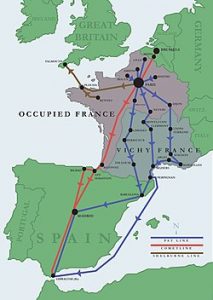
In November 1942, Wehrmacht troops occupied the southern part of France after the Allies’ Operation Torch had started. This gave the Germans and the Gestapo unrestricted access to all parts of Vichy France and made life more dangerous for Wake. When the network was betrayed that same year she decided to flee France. Her husband, Henri Fiocca, stayed behind. He later was captured, tortured, and executed by the Gestapo. She threw caution to the wind. She would “doll” herself up and be very flirtatious, almost daring them to search her. She took a chance, and they couldn’t see past her façade to the ruthless spy beneath the beauty she showed on the outside.
In 1943, when the Germans became aware of her, she escaped to Spain and continued on to the United Kingdom. After reaching Britain, Wake joined the Special Operations Executive (SOE) under the code name Hélène. On April 29-30, 1944 as a member of a three person SOE team code-named “Freelance,” Wake parachuted into the Allier department of occupied France to liaise between the SOE and several Maquis groups in the Auvergne region, which were loosely overseen by Emile Coulaudon (code name “Gaspard”). She participated in a battle between the Maquis and a large German force in June 1944. In the aftermath of the battle, she bicycled 500 kilometers to send a situation report to SOE in London. In early 1943, in the process of getting out of France, Wake was picked up with a whole trainload of people and was arrested in Toulouse, but was released four days later. The head of the O’Leary Line, Albert Guérisse, managed to have her released by claiming she was his mistress and was trying to conceal her infidelity to her husband (all of which was untrue). She succeeded in crossing the Pyrenees to Spain. Until the war ended, she was unaware of her husband’s death, and she subsequently blamed herself for it. Wake was a recipient of the George Medal from the United Kingdom, the Medal of Freedom from the United States, the Legion of Honor from France, and medals from Australia and New Zealand.
In 1985, Wake published her autobiography, “The White Mouse.” Later, after 40 years of marriage, her second husband John Forward died at Port Macquarie on 19 August 1997. The couple had no children. Wake sold her medals to fund herself saying, “There was no point in keeping them, I’ll probably go to hell and they’d melt anyway.” Strangely, this disregard of the value of war medals, seemed common among the war spies. In 2001, Wake left Australia for the last time and emigrated to London. She became a resident at the Stafford Hotel in Saint James’ Place, near Piccadilly, formerly a British and American forces club during the war. She had been introduced to her first “bloody good drink” there by Louis Burdet, the general manager at the time, who had 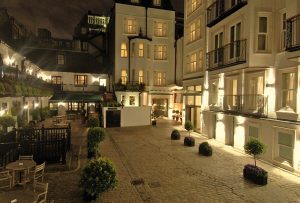 also worked for the Resistance in Marseille. Mornings usually found Wake in the hotel bar, sipping her first gin and tonic of the day. She was welcomed at the hotel, celebrating her ninetieth birthday there. Out of deep respect for her, the hotel owners absorbed most of the costs of her stay. In 2003, Wake chose to move to the Royal Star and Garter Home for Disabled Ex-Service Men and Women, in Richmond, London, where she remained until her death on Sunday evening August 7, 2011, aged 98, at Kingston Hospital, where she had been admitted with a chest infection. She had requested that her ashes be scattered at Montluçon in central France. Her ashes were scattered near the village of Verneix, which is near Montluçon, on March 11, 2013.
also worked for the Resistance in Marseille. Mornings usually found Wake in the hotel bar, sipping her first gin and tonic of the day. She was welcomed at the hotel, celebrating her ninetieth birthday there. Out of deep respect for her, the hotel owners absorbed most of the costs of her stay. In 2003, Wake chose to move to the Royal Star and Garter Home for Disabled Ex-Service Men and Women, in Richmond, London, where she remained until her death on Sunday evening August 7, 2011, aged 98, at Kingston Hospital, where she had been admitted with a chest infection. She had requested that her ashes be scattered at Montluçon in central France. Her ashes were scattered near the village of Verneix, which is near Montluçon, on March 11, 2013.
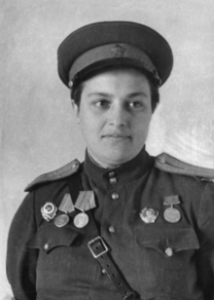 Lyudmila Mikhailivna Pavlichenko was a Soviet sniper in the Red Army during World War II, credited with 309 confirmed kills. Her record made her the most successful female sniper in history. Lyudmila was nicknamed “Lady Death” due to her incredible ability with a sniper rifle and her high kill count. She served in the Red Army during the Siege of Odessa and the Siege of Sevastopol, during the early stages of the Eastern Front in World War II. Born Lyudmila Mikhailovna Belova on July 12, 1916 in Bila Tserkva, Russian Empire (located within present-day Ukraine). Her mother was a teacher and her father was a Saint Petersburg factory worker.
Lyudmila Mikhailivna Pavlichenko was a Soviet sniper in the Red Army during World War II, credited with 309 confirmed kills. Her record made her the most successful female sniper in history. Lyudmila was nicknamed “Lady Death” due to her incredible ability with a sniper rifle and her high kill count. She served in the Red Army during the Siege of Odessa and the Siege of Sevastopol, during the early stages of the Eastern Front in World War II. Born Lyudmila Mikhailovna Belova on July 12, 1916 in Bila Tserkva, Russian Empire (located within present-day Ukraine). Her mother was a teacher and her father was a Saint Petersburg factory worker.
In June 1941, when Pavlichenko was 24 years old and in her fourth year studying history at Kiev University, Germany began its invasion of the Soviet Union. Pavlichenko was among the first round of volunteers at the Odessa recruiting office, where she requested to join the infantry. The registrar really wanted her to be a nurse, but she refused. She surprised her superiors, and after they saw that she had completed multiple training courses, they finally let her in the army as a sniper. Pavlichenko was assigned to the Red Army’s 25th Rifle Division. She became one of 2,000 female snipers in the Red Army. The number sounds large, but female soldiers were still just 2% of the Red Army’s total number. Of the 2,000 female snipers, only about 500 survived the war. Pavlichenko was given only a frag grenade due to weapon shortages, although she was in a combat role. On August 8, 1941 a fallen comrade handed her his Mosin-Nagant model 1891 bolt-action rifle. She finally had a real weapon, and with it she achieved her first two kills and proved herself to her comrades. She described this event that made her officially a sniper, her “baptism of fire.”
Pavlichenko fought for about two and a half months near Odessa, where she recorded 187 kills. She was promoted to Senior Sergeant in August 1941, when she reached 100 confirmed kills. At age 25, she married a fellow sniper whose name was Alexei Kitsenko. Unfortunately, soon after the marriage, Alexei was gravely wounded by a mortar shell. He died from his injuries after a few days in the hospital. When the Romanians gained control of Odessa on October 15, 1941, Pavlichenko’s unit was withdrawn by sea to Sevastopol on the Crimean Peninsula, where she fought for more than eight months. In Sevastopol, Pavlichenko trained almost a dozen snipers, who killed over a hundred Axis soldiers during the battle. In May 1942, newly promoted Lieutenant Pavlichenko was cited by the Southern Army Council for killing 257 Axis soldiers. Her total of confirmed kills during World War II was 309, including 36 enemy snipers. In June 1942, Pavlichenko was hit in the face with shrapnel from a mortar shell. After her injury, the Soviet High Command ordered that she be evacuated from Sevastopol by submarine. They didn’t want to lose this valuable, perfect example of Soviet womanhood. She spent around a month in the hospital, after which she expected to go back to the Eastern Front , but she didn’t. Instead she became a propagandist for the Red Army. She also trained snipers for combat duty till the end of the war in 1945.
In 1942, Pavlichenko was sent to Canada and the United States for a publicity visit. Her mission was to convince the allies to start a second front against Nazi Germany. When she visited the United States, she became the first Soviet citizen to be received by a US President, as Franklin D. Roosevelt welcomed her to the White House, and later she toured with Eleanor Roosevelt across America, relating her experiences as a female soldier on the front lines. Unfortunately, Pavlichenko was not taken seriously by the press during her tour, but was referred to as the “Girl Sniper.” I can’t imagine how the press could possibly connect a sniper with girlish innocence. She was dumbfounded by the kind of questions reporters put to her in Washington, DC. “One reporter even criticized the length of the skirt of my uniform, saying that in America women wear shorter skirts and besides my uniform made me look fat.” They also asked if she used makeup on the front line. She was described by the reporters as very blunt and unemotional in her responses. Pavlichenko appeared before the International Student Assembly being held in Washington, DC, attended the meetings of the Congress of Industrial Organizations, and made appearances and speeches in New York City and Chicago. In New York City, she was given a raccoon fur coat by Mayor LaGuardia. In Chicago, she stood before large crowds, chiding the men to support the second front. “Gentlemen,” she said, “I am 25 years old and I have killed 309 fascist invaders by now. Don’t you think, gentlemen, that you have been hiding behind my back for too long?” Her words settled on the crowd, then caused a surging roar of support.
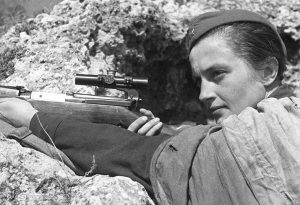 On Friday, November 12, 1942, Pavlichenko visited Coventry, accepting donations of £4,516 from local workers to pay for three X-ray units for the Red Army. She also visited Coventry Cathedral ruins, then the Alfred Herbert works and Standard Motor Factory, from where most funds had been raised. She had inspected a factory in Birmingham earlier in the day. Having attained the rank of major, Pavlichenko never returned to combat, but became an instructor and trained Soviet snipers until the war’s end. In 1943, she was awarded the Gold Star of the Hero of the Soviet Union, as well as the Order of Lenin twice. Lyudmilla Pavlichenko died on October 10, 1974, at the age of 58 years in Moscow, Soviet Union due to a stroke. She was a beloved hero of the Soviet Union.
On Friday, November 12, 1942, Pavlichenko visited Coventry, accepting donations of £4,516 from local workers to pay for three X-ray units for the Red Army. She also visited Coventry Cathedral ruins, then the Alfred Herbert works and Standard Motor Factory, from where most funds had been raised. She had inspected a factory in Birmingham earlier in the day. Having attained the rank of major, Pavlichenko never returned to combat, but became an instructor and trained Soviet snipers until the war’s end. In 1943, she was awarded the Gold Star of the Hero of the Soviet Union, as well as the Order of Lenin twice. Lyudmilla Pavlichenko died on October 10, 1974, at the age of 58 years in Moscow, Soviet Union due to a stroke. She was a beloved hero of the Soviet Union.
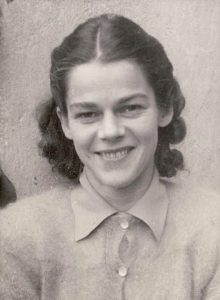 Milly Elise “Lise” Borsum was a Norwegian resistance member during World War II. Born on September 18, 1908 in Kristiania, she was the daughter of pianist and composer Eyvind Alnaes and his wife Emilie Thorne. She was married to physician Ragnar Borsum from 1930 to 1949, and was mother of actress Bente Borsum.
Milly Elise “Lise” Borsum was a Norwegian resistance member during World War II. Born on September 18, 1908 in Kristiania, she was the daughter of pianist and composer Eyvind Alnaes and his wife Emilie Thorne. She was married to physician Ragnar Borsum from 1930 to 1949, and was mother of actress Bente Borsum.
During the Holocaust, Lise and her husband had compassion on the Jewish people, making the fateful decision to harbor them from the Nazis. In April of 1943, Lise and her husband were arrested and incarcerated at the Grini concentration camp for two months. They had been members of a network which helped Jewish people escape to Sweden. On June 28, 1943, she was sent to Germany, with MS Monte Rosa from Oslo  to Arhus, and further with railway transport to Hamburg. She spent a short time at the Hütten Gefängnis in Hamburg before ending up as a Nacht und Nebel prisoner at the Ravensbrück concentration camp, which was a camp specifically for women. Nacht und Nebel was a directive issued by Adolf Hitler on December 7, 1941 targeting political activists and resistance “helpers” in World War II to be imprisoned or killed. Their families and the population usually knew nothing of their fate or whereabouts They were the Nazi state’s alleged offenders, often without trial or conviction or even charges. Victims who disappeared in these Night and Fog actions were often never heard from again. The prisoners usually had their heads shaved and their dignity removed in any horrific way
to Arhus, and further with railway transport to Hamburg. She spent a short time at the Hütten Gefängnis in Hamburg before ending up as a Nacht und Nebel prisoner at the Ravensbrück concentration camp, which was a camp specifically for women. Nacht und Nebel was a directive issued by Adolf Hitler on December 7, 1941 targeting political activists and resistance “helpers” in World War II to be imprisoned or killed. Their families and the population usually knew nothing of their fate or whereabouts They were the Nazi state’s alleged offenders, often without trial or conviction or even charges. Victims who disappeared in these Night and Fog actions were often never heard from again. The prisoners usually had their heads shaved and their dignity removed in any horrific way 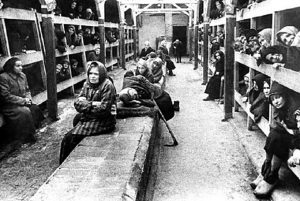 imaginable to bring them into submission.
imaginable to bring them into submission.
She was held at Ravensbrück until April 8, 1945, when the surviving Scandinavian prisoners were transported home with the White Buses organized by the Swedish Red Cross. She was one of the blessed few who walked away alive from the concentration camps. Many prisoners, political or otherwise were killed, starved, beaten, or worked to death. Lise Borsum managed to live through it. Later in life, she was known for her writings and for organizing work after the war. She went on to live a long life, dying on August 29, 1985 at the age of 76. She had done her part to help the Jewish people during the Holocaust, and she was not sorry.
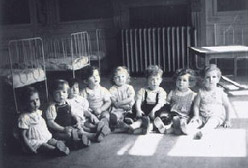 I was thinking about Sir Nicholas Winton, who saved 669 Jewish children from the brutal activities, and almost certain death that was being dealt out by Hitler during World War II. Of course, Sir Winton wasn’t the only person who stepped up to help wage their own battle against the Third Reich. Many people in Nazi occupied areas took in families in desperate need. When word is the deportations to the ghettos came down, some parents had to make the horrible choice to give their children to friends and neighbors to “hide” them in plain site, raising them as their own, and everyone hoping to be able to return them to their own parents after the war. The problem was that so many of the parents were killed in the camps.
I was thinking about Sir Nicholas Winton, who saved 669 Jewish children from the brutal activities, and almost certain death that was being dealt out by Hitler during World War II. Of course, Sir Winton wasn’t the only person who stepped up to help wage their own battle against the Third Reich. Many people in Nazi occupied areas took in families in desperate need. When word is the deportations to the ghettos came down, some parents had to make the horrible choice to give their children to friends and neighbors to “hide” them in plain site, raising them as their own, and everyone hoping to be able to return them to their own parents after the war. The problem was that so many of the parents were killed in the camps.
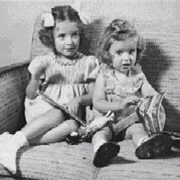
After the war was over, many of these children did not remember their parents. They were too young when they were given to people to care for. That created a new and almost more difficult situation. Some of the foster parents had fallen in love with the children in their care, and the viler knew no other family. Still, they were not their children. It was a heart wrenching situation. The other problem was that due to bombings, many of the homes housing these “hidden” children were gone, and they had no way to let anyone know where they had gone. That made it even more difficult to return the children. And some people couldn’t bear to part with the children anyway. 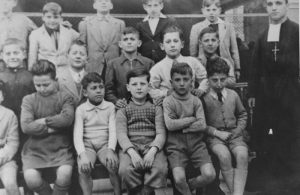 That left parents devastated and without recourse.
That left parents devastated and without recourse.
Some children were reunited with their parents quickly and some took years…if ever. I wonder about the ones that took years, because of the immense loss they must have felt over so much lost time. You just can’t get that time back, and you can’t change whatever the children endured in their lives. Everyone just had to let go of the past and go forward, as best they could. There was no way to go back to their pre-war lives. Each had changed, some were forever missing, and some were lost to the horrific hatred that was Hitler’s Third Reich.
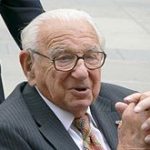 His name was Sir Nicholas George Winton MBE, but in his early years, he had not been bestowed with such an honor as knighthood. That came about much later in his life. Sir Winton was born on May 19, 1909 in Hampstead, London, England. He was a British humanitarian, born to German-Jewish parents, Rudolph Wertheim (1881–1937), a bank manager, and his wife Barbara (née Wertheimer, 1888–1978) who had emigrated to Britain. His parents had moved to London two years before he was born. The family name was Wertheim, but they changed it to Winton in an effort at integration. They also converted to Christianity, and Winton was baptized. God had a plan for Sir Winton’s life, although he would not know that for years.
His name was Sir Nicholas George Winton MBE, but in his early years, he had not been bestowed with such an honor as knighthood. That came about much later in his life. Sir Winton was born on May 19, 1909 in Hampstead, London, England. He was a British humanitarian, born to German-Jewish parents, Rudolph Wertheim (1881–1937), a bank manager, and his wife Barbara (née Wertheimer, 1888–1978) who had emigrated to Britain. His parents had moved to London two years before he was born. The family name was Wertheim, but they changed it to Winton in an effort at integration. They also converted to Christianity, and Winton was baptized. God had a plan for Sir Winton’s life, although he would not know that for years.
On the eve of World War II, Sir Winton knew what his calling had been, and he quietly set about orchestrating the rescue of 669 children, most of them Jewish, from Czechoslovakia. Sir Winton quickly found homes for the children and arranged for their safe passage to Britain. The operation was known as the Czech Kindertransport, which is German for “children’s transport, but it would not be called that right away. The transport was not a official operation, and was not sanctioned as such. He worked largely alone to set this up, and most people knew nothing about it for over 50 years, but the children did not forget the man they called the British Schindler, who had saved their lives.
Then, in 1988, he was invited to the BBC television program “That’s Life!.” It was a surprise party of sorts. Little 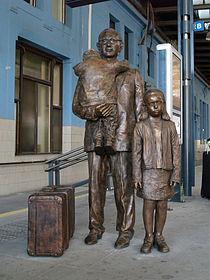 did Sir Winton know, but his secret was no longer such a secret. Arriving at the show, Sir Winton was seated in a room full of people he did not know. Soon, the truth was told to him, and he found out that the “audience” was in fact a number of the children he had rescued all those years ago. The grateful children, now grown adults, wanted to reunite with the man who had saved then all those years ago. It was the British press who celebrated him and dubbed him the “British Schindler.” Sir Winton was brought to tears, as he looked around him at all of these people who owed him their very lives, but his story did not end there. In 2003, Nicholas Winton became Sir Nicholas George Winton MBE (Most Excellent Order of the British Empire), when he was knighted by Queen Elizabeth II for “services to humanity, in saving Jewish children from Nazi Germany occupied Czechoslovakia.” Then, on October 28, 2014, he was awarded the highest honor of the Czech Republic, the Order of the White Lion (1st class), by Czech President Miloš Zeman. The little German-Jewish boy, whose family converted to Christianity, and who always felt a love for humanity and those in need, had become a great man indeed. God did have a plan for his life, and Sir Winton had made God proud. Sir Nicholas George Winton MBE passed away peacefully in his sleep on July 1, 2015, at Wexham Park Hospital, Slough, Berkshire, England, at the age of 106 years, having lived a full life. After the war, Winton worked for the International Refugee Organization and then the International Bank for Reconstruction and Development in Paris, where he met Grete Gjelstrup, a Danish secretary and accountant’s daughter. They married in her hometown of Vejle on October 31, 1948. The couple settled in Maidenhead, England, where they raised their three children: Nick (born 1951), Barbara (born 1954) and the youngest Robin (1956–1962), who was born
did Sir Winton know, but his secret was no longer such a secret. Arriving at the show, Sir Winton was seated in a room full of people he did not know. Soon, the truth was told to him, and he found out that the “audience” was in fact a number of the children he had rescued all those years ago. The grateful children, now grown adults, wanted to reunite with the man who had saved then all those years ago. It was the British press who celebrated him and dubbed him the “British Schindler.” Sir Winton was brought to tears, as he looked around him at all of these people who owed him their very lives, but his story did not end there. In 2003, Nicholas Winton became Sir Nicholas George Winton MBE (Most Excellent Order of the British Empire), when he was knighted by Queen Elizabeth II for “services to humanity, in saving Jewish children from Nazi Germany occupied Czechoslovakia.” Then, on October 28, 2014, he was awarded the highest honor of the Czech Republic, the Order of the White Lion (1st class), by Czech President Miloš Zeman. The little German-Jewish boy, whose family converted to Christianity, and who always felt a love for humanity and those in need, had become a great man indeed. God did have a plan for his life, and Sir Winton had made God proud. Sir Nicholas George Winton MBE passed away peacefully in his sleep on July 1, 2015, at Wexham Park Hospital, Slough, Berkshire, England, at the age of 106 years, having lived a full life. After the war, Winton worked for the International Refugee Organization and then the International Bank for Reconstruction and Development in Paris, where he met Grete Gjelstrup, a Danish secretary and accountant’s daughter. They married in her hometown of Vejle on October 31, 1948. The couple settled in Maidenhead, England, where they raised their three children: Nick (born 1951), Barbara (born 1954) and the youngest Robin (1956–1962), who was born 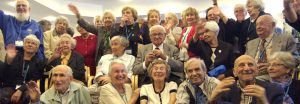 with Down syndrome. At the family’s insisted Robin stayed with them, rather than being sent to a residential home. Sir Winton’s son, Robin died of meningitis, the day before his sixth birthday. The death was devastating for Winton and he founded a local support organization that later became Maidenhead Mencap. Winton stood, unsuccessfully, for the town council in 1954, but later found work in the finance departments of various companies. His wife, Grete preceded him in death in 1999. Sir Nicholas George Winton MBE was a truly remarkable man.
with Down syndrome. At the family’s insisted Robin stayed with them, rather than being sent to a residential home. Sir Winton’s son, Robin died of meningitis, the day before his sixth birthday. The death was devastating for Winton and he founded a local support organization that later became Maidenhead Mencap. Winton stood, unsuccessfully, for the town council in 1954, but later found work in the finance departments of various companies. His wife, Grete preceded him in death in 1999. Sir Nicholas George Winton MBE was a truly remarkable man.

